Costa Rica
Tour and Panama Cruise with CruiseWest
The Panama Canal * Photos
and text by Jack
Yeazel
Return
to Home Page
GENERAL:
The canal is 51 miles long and cuts through
the isthmus of Panama, connecting the Atlantic and Pacific Oceans.
Because of the S shape of Panama, the Atlantic lies to the west of the
canal and the Pacific to the east, reversing the normal orientation.
It takes about nine hours for a ship to traverse the canal.
The canal has two sets of locks on the Pacific
side and one on the Atlantic. At the Atlantic end, the massive steel
miter gates of the triple locks at Gatún are 70 feet high and weigh
745 tons each, but are so well counterbalanced that a 40 horsepower motor
suffices to open and close them. Lake Gatún, which is 85 feet
above sea level, is fed by the Chagres River, which was dammed to make
the lake. The gates (all original) will float when towed to a dry
dock for maintenance every 10 to 15 years. The locks can handle ships
up to 106' beam, 965' length, and 39.5' (fresh water) draft. Each
chamber measures 110' wide by 1,000' long.
From Lake Gatún, the canal passes through
the Continental Divide at the Gaillard Cut, and then descends to the Pacific
first through a single set of locks at Pedro Miguel to Miraflores Lake
at 54 feet above sea level, and then through a double set of locks at Miraflores.
All the locks on the canal are paired so that ships may pass in both directions.
The ships are guided through the locks by small railway engines.
The Pacific end of the canal is 10 inches higher than the Atlantic end
and has much greater tides requiring that gate to be higher than on the
Atlantic end. (Notice the tide change on the "Oro" page.)
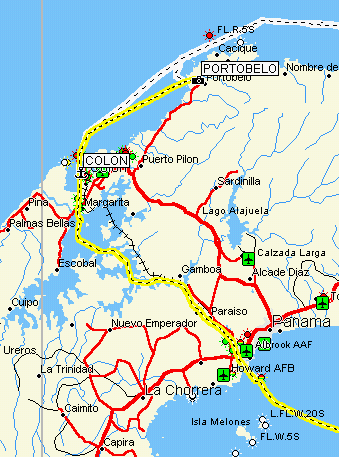 ....
....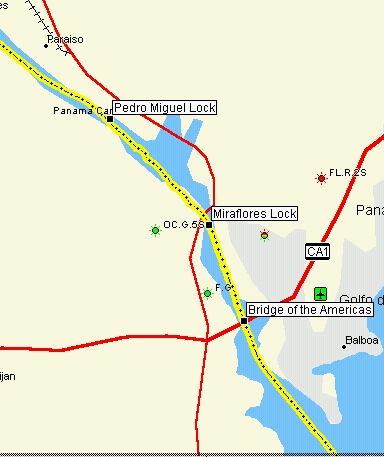
The Miraflores are two-stage locks, and the Pedro Miguel is a one
stage lock.

Profile of the canal locks
We entered the canal at about 6:00pm, so there wasn't enough light
to photograph the Gatun Locks.
Click on the
following thumbnails for larger views
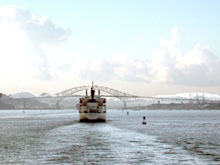 .....
.....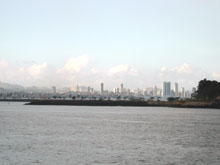 .....
.....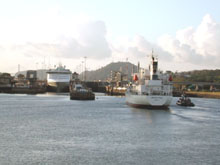
-
Approaching the Bridge of the Americas.
-
Panama City is to the right.
-
We follow a "sister" ship, the United
Cool, a ship about the same length as the Pacific Explorer. Two
ships of this length can enter the locks together to speed up the general
traffic flow.
 .....
.....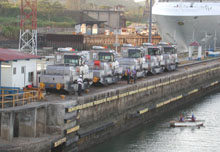 .....
.....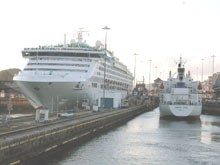
-
A crew of at least four ACP workers (a
pilot and three line handlers) board the Pacific Explorer.
-
Locomotives lined up to assist the ships.
The men in the small boat receive lines from the ship and pass them to
four (or eight) locomotives, two at the bow and two at the stern.
-
Here's that "floating hotel" again!
A ship of that size requires four canal pilots.
 .....
.....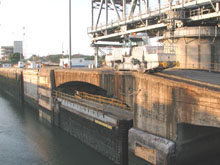 ...
...
-
Locomotive on the opposing side.
They do not pull the ships, but just keep them centered.
-
The lock gates have opened for the two
ships to enter the lock. The structure is a 'swing bridge'.
-
The Hotel cruises into the Pacific.
The swing bridge wasn't used after the Bridge of the Americas was built.
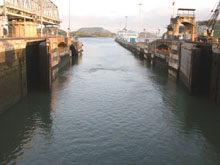 .....
.....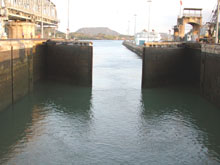 ...
...
Lock gates close behind the Pacific
Explorer
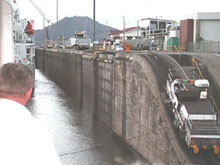 .....
..... ...
...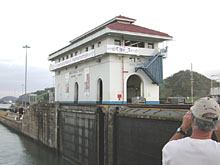
-
This locomotive is one of two that control
the bow of the ship. It takes four to guide the ships.
-
And this locomotive has a line attached
to the stern. Each new locomotive costs about $1,000,000.
-
Miraflores control tower. The lock
has been filled, so the ship can continue into Lake Miraflores.
The Panama Canal Treaty of 1977 turned the canal over to Panama at midnight
Dec. 31, 1999. So, since 1999 the canal has been operated by the
Panama Canal Authority (ACP). The ACP continues to maintain the locks
and widen the Gaillard cut. This narrowest part of the canal has
been widened from 450' to 630' to allow two-way ship traffic and the widening
continues today. Also, fluorescent lights have been placed along
the edge of the Gaillard cut to enable safer night traffic.
NOTE: Our Captain, Hernán Lara, piloted a ship through
the canal on the first day the canal was controlled by Panama.
 ....
....

 .....
..... .....
.....



 .....
..... ...
...
 .....
..... ...
...


